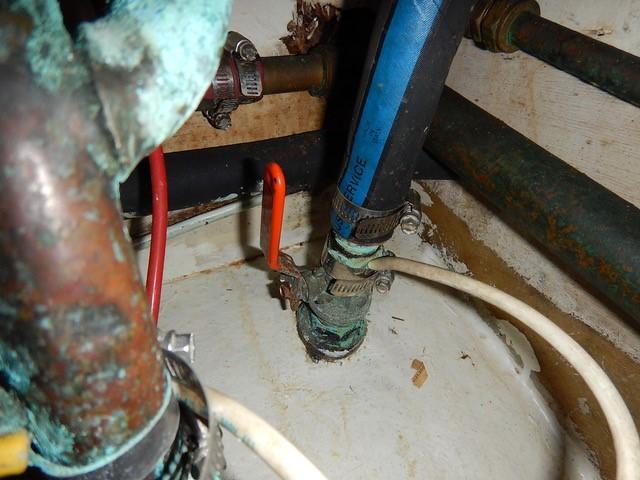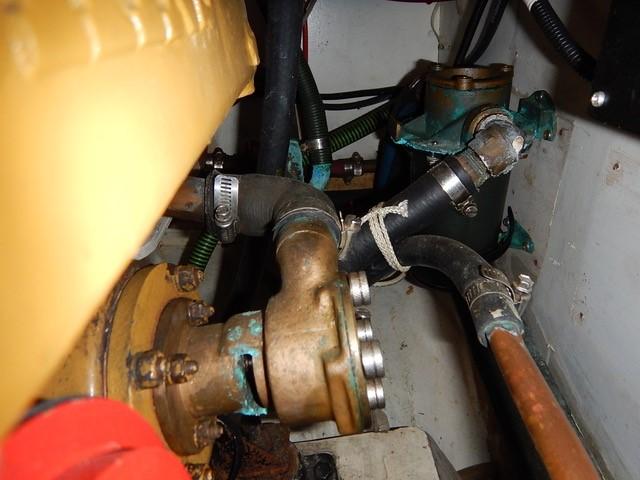Welcome Back › Forums › Deck and Hull › Thu-hulls and seacocks › size of raw water inlet seacock?
- This topic has 4 replies, 4 voices, and was last updated 5 years, 11 months ago by
 Voltair.
Voltair.
-
AuthorPosts
-
February 6, 2019 at 02:28 #26537
 ModeratorKeymaster
ModeratorKeymasterCan anyone tell us what is the diameter of the seacock on the raw water inlet?
We have a Groco SV type seacock on the engine raw water inlet, which is in need of replacing. We need to buy a new seacock and strainer, but are confused about the size of the hole in the hull for the raw water inlet. Our notes say it is 1-1/2″, but our eyes suggest it is only a 3/4″ seacock. Our boat is in the water now, so not easily measured. Before I jump over the side, I thought it worth asking if someone has advice on replacing this seacock and strainer.
Here’s a photo of our current setup.
February 10, 2019 at 19:48 #26545racepassage
ParticipantHi Marilyn,
As your access appears difficult and this looks like it might be a dry-docking job anyway have attached pics illustrating the set up on RP.
Have installed typical through hull shut off valve and have the strainer removed and installed on the E/R forward bulkhead more or less just in front of the engine mounted S/W pump. By doing this will allow you easy access to your new strainer through the aperture behind the saloon steps. The hose size throughout, pump to strainer/strainer to through hull, can then be dependent upon the hose attaching to the water pump.
The pictures show better than my explanation.
Just a thought Marilyn.

 February 11, 2019 at 01:56 #26546
February 11, 2019 at 01:56 #26546 ModeratorKeymaster
ModeratorKeymasterThanks Roger – we’ve considered this, but the main reason why we do not want to do this is that, if the raw water inlet becomes clogged at the thru-hull (think plastic bag), it is possible to remove the strainer cap and shove something down past the thru-hull to clear the blockage. We’ve never needed to do that yet, but we’re always looking for ways to avoid serious future problems.
One other thing is that we have the low-line Perkins engine with the heat exchanger on the fwd end of the engine. That area is extremely crowded – there is no room to put the strainer on the fwd bulkhead. So a remote mounted strainer would end up on the engine room aft bulkhead, which means lifting the starboard engine hatch anyway.
Roger – do you still have the Thamesway gearbox? Ours is raw water cooled, meaning it is the first connection past the strainer. The raw water pump mounted on the fwd end of the engine pulls the water through the gearbox cooling circuit and pushes the water through the heat exchanger. It seems odd to me that the gearbox requires this raw water cooling – any thoughts on that?
Also – do you know if that is a 3/4″ thru-hull? Sure looks it.
Cheers – Marilyn
March 5, 2019 at 01:57 #26555Nicholas Fairhust
ParticipantEvening Marilyn,
Looking at your photo it looks as if the skin fitting is most likely 1″ OD as the valve assembly has what looks like a 1″ OD bib connecting it to the old pattern Groco filter body on which you have the 1″ outlet stepped up to a 1 -1/2″ OD feed.. The important dimension for your engine cooling is the ID or inside diameter of the smallest aperture in the feed system to the engine ! The engine specs will advise you of this particularly for tropical waters. I concur with your plastic bag scenario but check that you do not have a filter rose or grid on the outboard side of the skin fitting / through hull as they were sometime fitted to engine inlets – you might put your cleaning rod through it whilst dodging the water spout ? The old Groco SV filter body and valve are really well made and difficult to better now – why not give it a good check over on haul out and recondition it with new bolts and gasket if it is as good as it looks ?
Rampant is 30% through her refit and looking even more beautiful than ever – even made it onto the front page of the local newspaper (we do not get many blue water ketches up here on the mountain)….
Nick & # 53
April 15, 2019 at 15:49 #26573 VoltairParticipant
VoltairParticipantHello Marilyn – the strainer on Voltair was about an inch in diameter and was bigger than the pipe connecting it to the outside world. When we got the whole lot clogged up with jelly-fish in southern norway, and the engine overheated, we were able to poke our wooden fuel-tank measuring stick down the middle of the whole lot to push out the debris. That stick was about ring-finger diameter, which gives a clue as to the size of the through-hull.
Having spent some time with Kevin at Thamesway who repaired two gearboxes for us over the years, he said they could get quite hot with all those planetary cogs whizzing around and that cooling the oil down definitely made a difference to the animal. Perhaps this was considered more necessary in the warmer waters above 25C than it was in temperate climates – both our breakdowns were in the mediterranean! The other thing we noticed when we bought the yacht was that the usual doubling of the jubilee clips on flexible pipes which go to through-hulls stopped as soon as you got to the strainer, which was just as deep in the water as the through-hull. In fact, the whole gearbox and raw water pump was below the waterline, so we used up quite a lot of jubilee clips doing belt and braces exercises. The pump still dripped though, so we also drilled a wine-bottle cork sized hole in the sump to drain it to the bilge (another thread, I think), and ran with nappies under the engine to catch the inevitable 4-108 oil leaks.
-
AuthorPosts
- You must be logged in to reply to this topic.